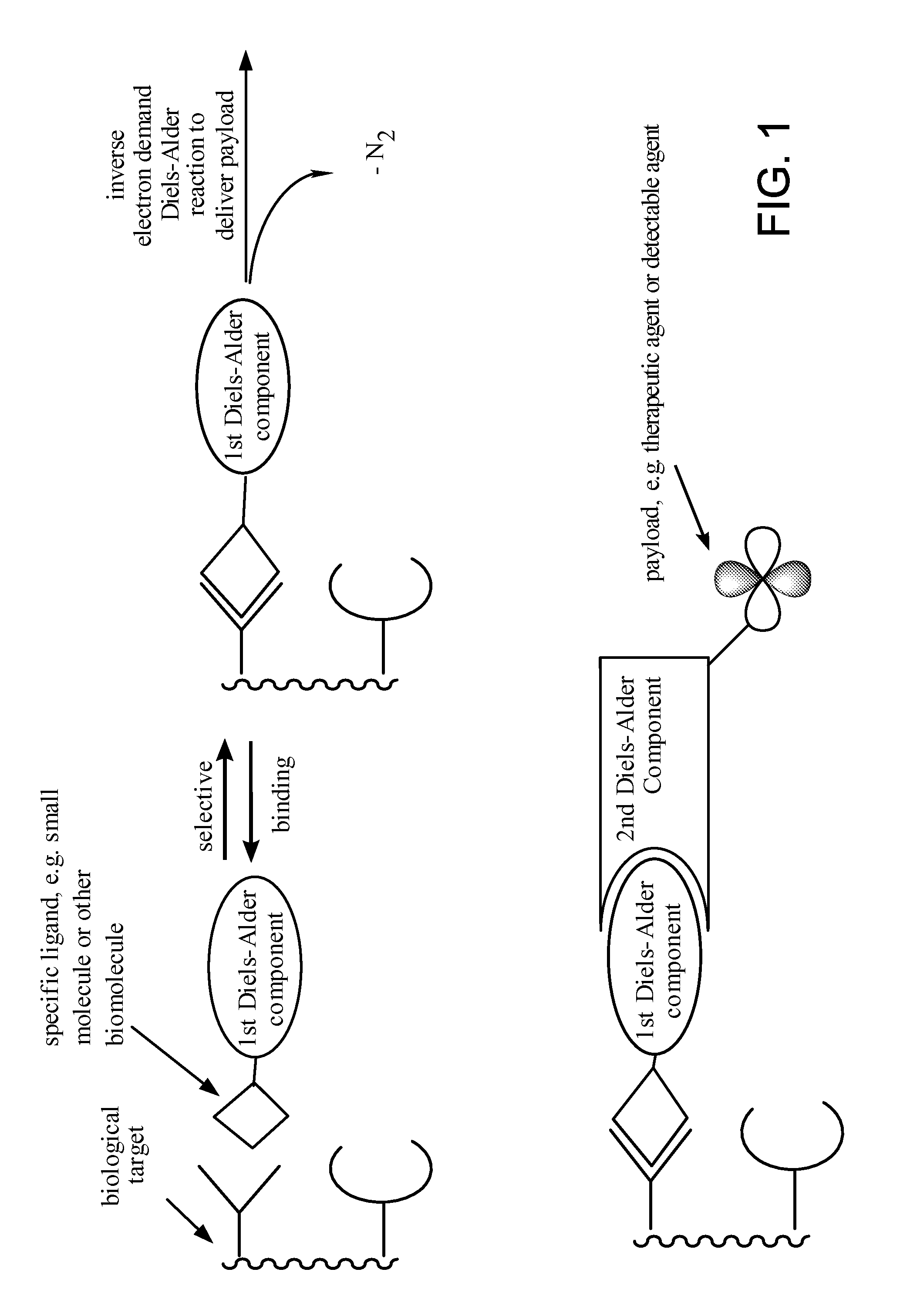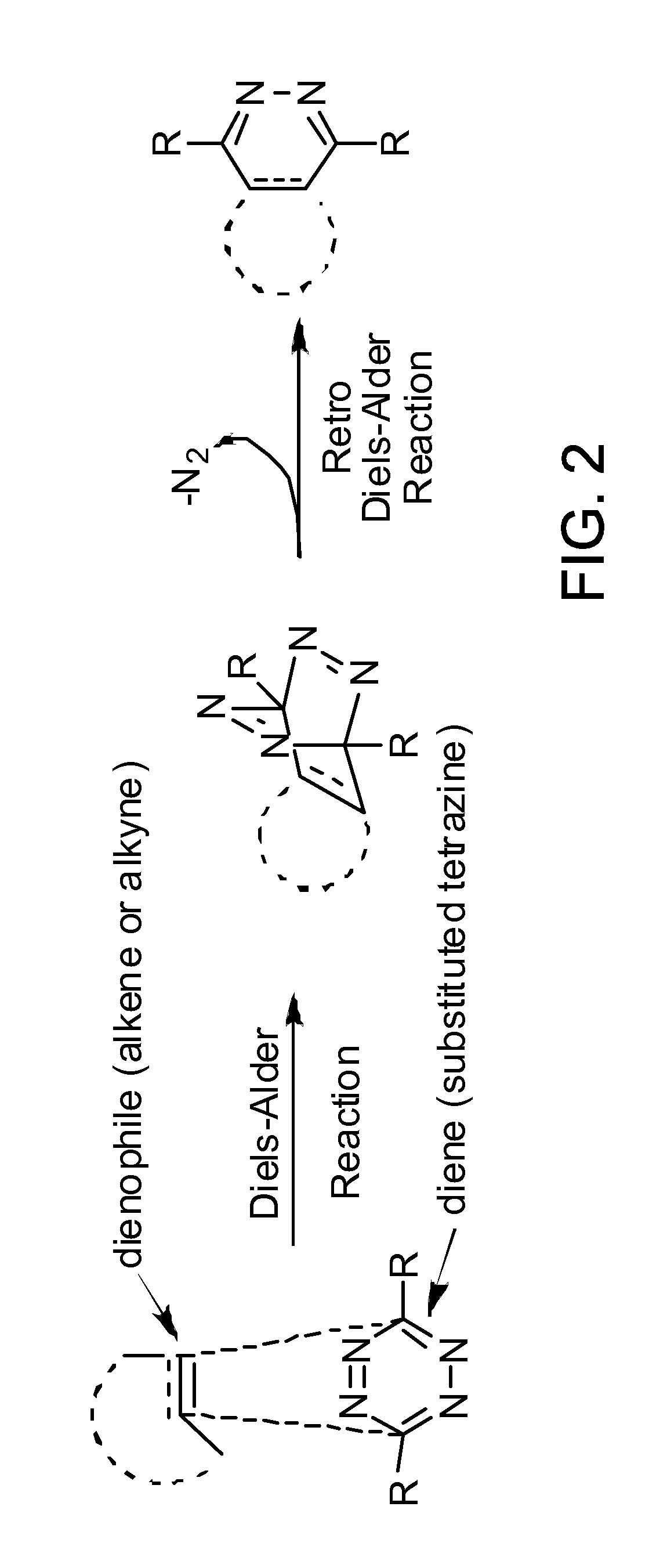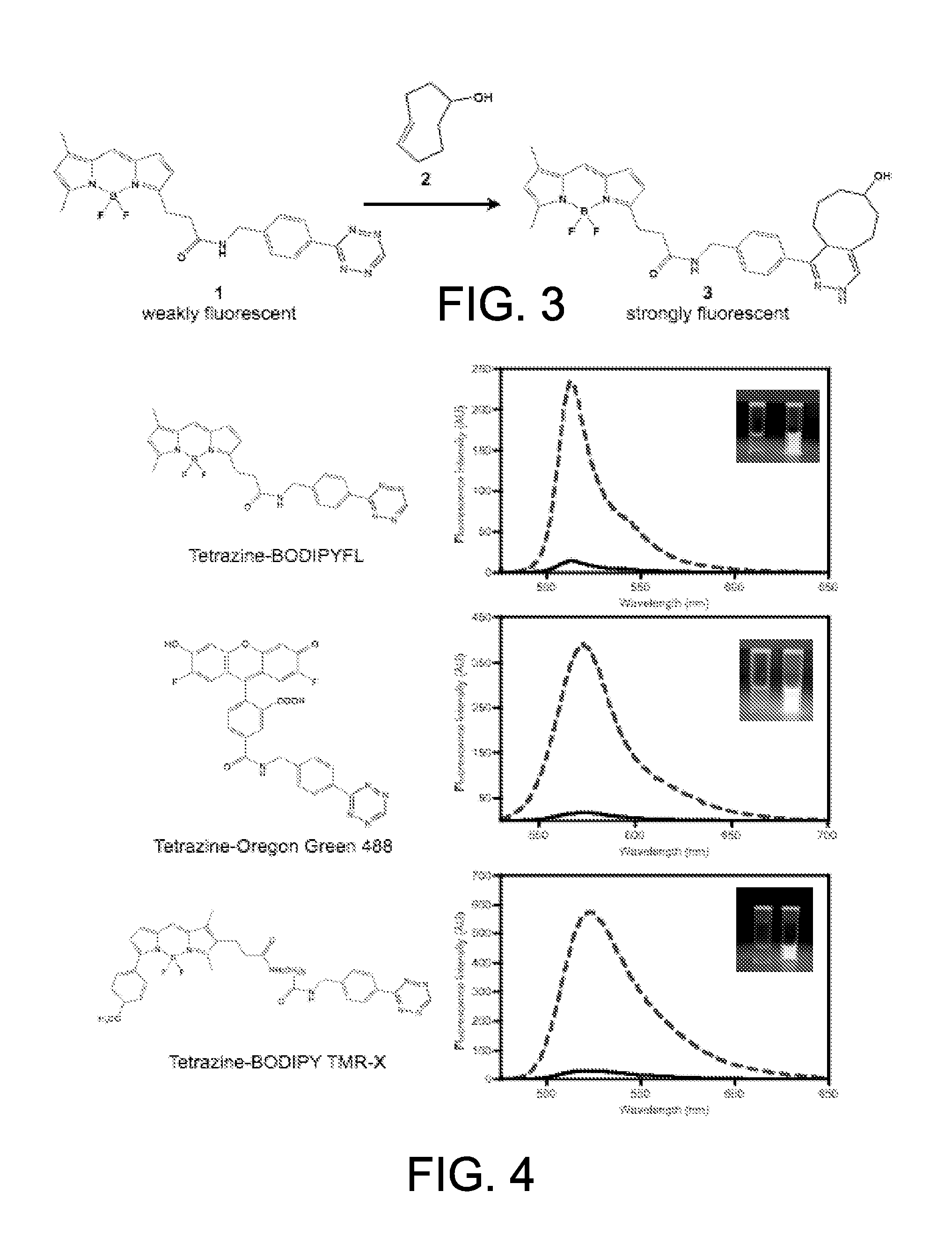Compositions and methods for delivering a substance to a biological target
a biological target and composition technology, applied in the field of compositions and methods for delivering a substance to a biological target, can solve the problems of inability to accurately label and image intracellular targets, largely limited to extracellular targets, and inability to apply click chemistry to living systems
- Summary
- Abstract
- Description
- Claims
- Application Information
AI Technical Summary
Benefits of technology
Problems solved by technology
Method used
Image
Examples
example 1
3-(p-Benzylamino)-tetrazine-VT680 Conjugate (3)
[0095]The following example describes an exemplary method of synthesis of 3-(p-benzylamino)-tetrazine-VT680 conjugate.
Step 1. Synthesis of 3-(p-Benzylamino)-1,2,4,5-tetrazine
[0096]
[0097]To a thoroughly blended mixture of 4-(aminomethyl)benzonitrile hydrochloride (25 mmol, 4.21 g), formamidine acetate salt (100 mmol, 10.41 g) and sulfur (25 mmol, 801 mg) was added anhydrous hydrazine (7.84 mL, 250 mmol). After addition of the hydrazine, the reaction mixture became a thick, clear slurry with gas evolution. After stirring vigorously for 20 hours, the now yellow slurry was added to acetic acid (50 mL) and filtered through a glass frit.
[0098]Sodium nitrite (125 mmol, 8.63 g) in 15 mL of water was then added to the acetic acid solution, cooled in an ice / water bath, over 15 minutes (Caution: the sodium nitrite addition generates a large amount of toxic nitrogen oxide gasses and should be performed in a well ventilated fume hood). During the so...
example 2
Synthesis of Additional 3-(p-Benzylamino)-tetrazine-fluorophore Conjugates
General Procedure for the Synthesis of Tetrazine Fluorophore Conjugates.
[0102]To a solution of 3-(4-benzylamino)-1,2,4,5-tetrazine (10 μmol) in anhydrous DMF (0.5 mL) was added the succinimidyl ester of the appropriate fluorophore (2.5 μmol) and triethylamine (10 μmol). The resulting solution was allowed to shake overnight in the dark. The crude reaction mixture was then purified by preparative reverse phase HPLC using a gradient from 0 to 100% buffer B. The identity and purity of the conjugates were confirmed by electrospray mass spectrometry and analytical HPLC, respectively. Via this procedure the following conjugates were prepared: tetrazine-BODIPY FL, tetrazine-BODIPY TMR-X, tetrazine-Oregon Green 488, tetrazine-BODIPY 650-665, and tetrazine-coumarin using the succinimidyl esters of BODIPY-FL, BODIPY TMR-X, Oregon Green 488, BODIPY 650-665, and 7-diethylaminocoumarin-3-carboxylic acid, respectively.
example 3
5-(4-(1,2,4,5-Tetrazin-3-yl)benzylamino)-5-oxopentanoic Acid
[0103]The following example describes an exemplary method of synthesis of 5-(4-(1,2,4,5-Tetrazin-3-yl)benzylamino)-5-oxopentanoic acid.
[0104]To a solution of 3-(p-benzylamino)-1,2,4,5-tetrazine (9.4 mg, 0.05 mmol) in anhydrous DMF (1.5 mL) was added glutaric anhydride (22.8 mg, 0.2 mmol) and triethylamine (7 μL, 0.05 mmol). The resulting solution was allowed to stir for 3 hours. The crude product was purified by preparative reverse-phase HPLC using a gradient from 0 to 100% buffer B over 30 minutes. After solvent removal, pure 5-(4-(1,2,4,5-tetrazin-3-yl)benzylamino)-5-oxopentanoic acid (9.9 mg, 66%) was isolated as a pink solid. 1H NMR (400 MHz, CD3OD): δ 10.31 (1H, s), 8.55 (2H, d, J=6.8 Hz), 7.55 (2H, d, J=6.8 Hz), 4.50 (2H, s), 2.37-2.33 (4H, m), 1.93 (2H, pentet, J=5.8 Hz). LRMS-ESI [M+H]+ m / z calcd. for [C14H16N5O3]+ 302.12, found 302.2.
PUM
| Property | Measurement | Unit |
|---|---|---|
| molecular weight | aaaaa | aaaaa |
| dihedral angle | aaaaa | aaaaa |
| pH | aaaaa | aaaaa |
Abstract
Description
Claims
Application Information
 Login to View More
Login to View More - R&D
- Intellectual Property
- Life Sciences
- Materials
- Tech Scout
- Unparalleled Data Quality
- Higher Quality Content
- 60% Fewer Hallucinations
Browse by: Latest US Patents, China's latest patents, Technical Efficacy Thesaurus, Application Domain, Technology Topic, Popular Technical Reports.
© 2025 PatSnap. All rights reserved.Legal|Privacy policy|Modern Slavery Act Transparency Statement|Sitemap|About US| Contact US: help@patsnap.com



